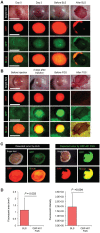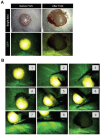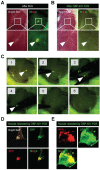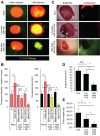Adenoviral targeting of malignant melanoma for fluorescence-guided surgery prevents recurrence in orthotopic nude-mouse models
- PMID: 26701857
- PMCID: PMC4951309
- DOI: 10.18632/oncotarget.6670
Adenoviral targeting of malignant melanoma for fluorescence-guided surgery prevents recurrence in orthotopic nude-mouse models
Abstract
Malignant melanoma requires precise resection in order to avoid metastatic recurrence. We report here that the telomerase-dependent, green fluorescent protein (GFP)-containing adenovirus OBP-401 could label malignant melanoma with GFP in situ in orthotopic mouse models. OBP-401-based fluorescence-guided surgery (FGS) resulted in the complete resection of malignant melanoma in the orthotopic models, where conventional bright-light surgery (BLS) could not. High-dose administration of OBP-401 enabled FGS without residual cancer cells or recurrence, due to its dual effect of cancer-cell labeling with GFP and killing.
Keywords: OBP-401; adenovirus; fluorescence-guided surgery (FGS); melanoma; nude mice.
Conflict of interest statement
Y. Urata is President & CEO of Oncolys BioPharma, Inc., the manufacturer of OBP-401. T. Fujiwara is a consultant of Oncolys BioPharma, Inc. S. Yano, K. Takehara, and R. M. Hoffman are or were unsalaried associates at AntiCancer, Inc.
Figures







Similar articles
-
Advantages of patient-derived orthotopic mouse models and genetic reporters for developing fluorescence-guided surgery.J Surg Oncol. 2018 Aug;118(2):253-264. doi: 10.1002/jso.25150. Epub 2018 Aug 6. J Surg Oncol. 2018. PMID: 30080930 Free PMC article. Review.
-
Targeting tumors with a killer-reporter adenovirus for curative fluorescence-guided surgery of soft-tissue sarcoma.Oncotarget. 2015 May 30;6(15):13133-48. doi: 10.18632/oncotarget.3811. Oncotarget. 2015. PMID: 26033451 Free PMC article.
-
Eradication of osteosarcoma by fluorescence-guided surgery with tumor labeling by a killer-reporter adenovirus.J Orthop Res. 2016 May;34(5):836-44. doi: 10.1002/jor.23073. Epub 2015 Nov 3. J Orthop Res. 2016. PMID: 26479501
-
Experimental Curative Fluorescence-guided Surgery of Highly Invasive Glioblastoma Multiforme Selectively Labeled With a Killer-reporter Adenovirus.Mol Ther. 2015 Jul;23(7):1182-1188. doi: 10.1038/mt.2015.63. Epub 2015 Apr 21. Mol Ther. 2015. PMID: 25896244 Free PMC article.
-
Toward Curative Fluorescence-Guided Surgery of Pancreatic Cancer.Hepatogastroenterology. 2015 May;62(139):715-22. Hepatogastroenterology. 2015. PMID: 26897960 Review.
Cited by
-
Eradication of melanoma in vitro and in vivo via targeting with a Killer-Red-containing telomerase-dependent adenovirus.Cell Cycle. 2017 Aug 18;16(16):1502-1508. doi: 10.1080/15384101.2016.1249548. Epub 2017 Jan 5. Cell Cycle. 2017. PMID: 28055296 Free PMC article.
-
Advantages of patient-derived orthotopic mouse models and genetic reporters for developing fluorescence-guided surgery.J Surg Oncol. 2018 Aug;118(2):253-264. doi: 10.1002/jso.25150. Epub 2018 Aug 6. J Surg Oncol. 2018. PMID: 30080930 Free PMC article. Review.
-
Bone and Soft-Tissue Sarcoma: A New Target for Telomerase-Specific Oncolytic Virotherapy.Cancers (Basel). 2020 Feb 18;12(2):478. doi: 10.3390/cancers12020478. Cancers (Basel). 2020. PMID: 32085583 Free PMC article. Review.
-
Fluorescence-guided surgery of a highly-metastatic variant of human triple-negative breast cancer targeted with a cancer-specific GFP adenovirus prevents recurrence.Oncotarget. 2016 Nov 15;7(46):75635-75647. doi: 10.18632/oncotarget.12314. Oncotarget. 2016. PMID: 27689331 Free PMC article.
-
Tumor-Specific Labeling of Pancreatic Cancer Using a Humanized Anti-CEA Antibody Conjugated to a Near-Infrared Fluorophore.Ann Surg Oncol. 2018 Apr;25(4):1079-1085. doi: 10.1245/s10434-018-6344-6. Epub 2018 Jan 25. Ann Surg Oncol. 2018. PMID: 29372363 Free PMC article.
References
Publication types
MeSH terms
Grants and funding
LinkOut - more resources
Full Text Sources
Other Literature Sources

